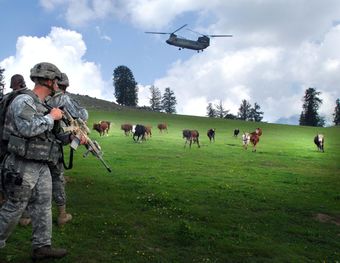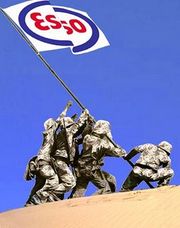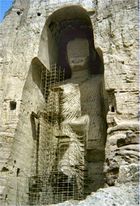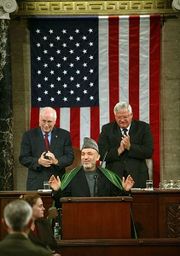War in Afghanistan (2001–present)
The War in Afghanistan (2001–present), more commonly known as The First Great Oil War, refers to the intervention by North Atlantic Treaty Organisation (NATO) and allied forces in the ongoing Afghan civil war. It is confusingly called the "Afghanistan War" by idiots that don't realize that Afghanistan has been in a permanent state of war since God Allah made the world. The war began on 7 October 2001 when George W Bush and Tony Blair decided to liberate the oilfields of Afghanistan.
Background[edit | edit source]
The origins of the First Great Oil War can be traced back to the insurgency against the Soviet occupation of Afghanistan in the 1980s. The American government decided to help the noble freedom fighters the Mujahideen to resist Soviet occupation by providing them with $billions in weapons and training.
Once the Mujahideen had liberated Afghanistan from the Soviet occupation these noble freedom fighters changed their names to the Taliban and began liberating the country from other evil influences such as music, literacy, sexy women and Buddhist statues.
At first the notoriously puritanical Americans approved of this activity, being extremely fond of banning things themselves. The American government even invited the Taliban to visit America in April 1998 to discuss what kind of things they could ban together, such as the cruel oppression of the Afghan oilfields.
Following this meeting relations with America chilled, due to the fact that the Taliban saw themselves as the only rightful liberators of Afghanistan and took exception to Bush's idea that they should let America help them liberate the Afghan oilfields.
Pretext for war[edit | edit source]
Once relations with the Taliban had broken down entirely, the American government decided that they would have to intervene to save the endangered oilfields. They realised that the insanely paranoid Muslim world would probably get the wrong idea and jump to the conclusion that they were trying to steal the oilfields instead of liberate them.
A plan was devised to allow a group of Islamic Fundamentalists to attack America, this attack was arranged on 11 September 2001 to commemorate America's noble liberation of Chile from the threat of socialist democracy on 11 September 1973.
Most of the terrorists that carried out the 11/9[1] attacks were actually from Saudi Arabia, but the American government didn't really care about that, since all these bloody ragheads look the same anyway. They claimed that the Taliban in Afghanistan were harbouring Al-Qaeda and Osama Bin Laden.
Invasion[edit | edit source]

Once the cynical and self serving Westerners had turned on their brave and heroic former allies in Afghanistan, war became inevitable.
The invasion began on 7 October 2001 less than a month after the "pretext" happened. America and Britain attacked various targets across Afghanistan.
The first victorious moment for the American forces came 2 days after the official start of the war. On 9 October four United Nations peacekeepers were defeated to the east of Kabul in Operation Collateral Damage. Other early victories in the campaign included the defeat of 4 Canadians at Tarnak Farm on 18 April 2002. And the overwhelming defeat of a hostile wedding reception in Uruzgan Province on 1 July 2002 resulting in the death of 48 belligerent wedding guests and the injury of 117 others.
Over the following years the American led occupation secured a number of other victories including the defeat of three British soldiers in October 2007 in Operation Friendly Fire[2] and the heroic Kunduz Airstrike in 2009 which resulted in the defeat of at least 90 oil oppressors who had been trying to steal some of the oil the US forces had worked so hard to liberate.[3]
Post invasion governance[edit | edit source]
An interim government was established on 21 December 2001 under the leadership of the American's hand picked man Hamid Karzai (a former CIA informant). The first elections in Afghanistan were won by Hamid Karzai in 2004 to make him the first democratically elected leader of Afghanistan.
In 2009 Karzai won his second election which featured lack of security, low voter turnout, widespread ballot box stuffing, intimidation, and other electoral fraud. He was finally declared the leader of Afghanistan by the Afghan high court. An election that was considered to have easily matched the standards of participatory democracy set by the United States and the European Union.
Civilian casualties[edit | edit source]
According to independent estimates around 39% of the innocent civilians to have been killed during the war have been killed by the United States and their allies.
These figures are disputed by the US administration who claim that 0% of the 0 innocent civilians to have died were killed by the US and allied forces. Opponents of the war have pointed out that if the US estimate of 0 civilian casualties is to be believed the United States administration are responsible for 100% of them, and should therefore be tried for war crimes.
See also[edit | edit source]
References[edit | edit source]
- ↑ 1source: the rest of the World
- ↑ 'Friendly fire' kills UK soldiers
- ↑ Video of the heroic Kunduz Airstrike


